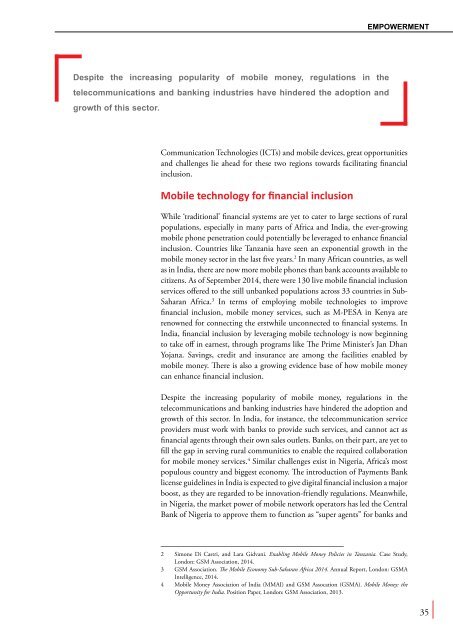Common Futures
II3UUw
II3UUw
Create successful ePaper yourself
Turn your PDF publications into a flip-book with our unique Google optimized e-Paper software.
Empowerment<br />
Despite the increasing popularity of mobile money, regulations in the<br />
telecommunications and banking industries have hindered the adoption and<br />
growth of this sector.<br />
Communication Technologies (ICTs) and mobile devices, great opportunities<br />
and challenges lie ahead for these two regions towards facilitating financial<br />
inclusion.<br />
Mobile technology for financial inclusion<br />
While ‘traditional’ financial systems are yet to cater to large sections of rural<br />
populations, especially in many parts of Africa and India, the ever-growing<br />
mobile phone penetration could potentially be leveraged to enhance financial<br />
inclusion. Countries like Tanzania have seen an exponential growth in the<br />
mobile money sector in the last five years. 2 In many African countries, as well<br />
as in India, there are now more mobile phones than bank accounts available to<br />
citizens. As of September 2014, there were 130 live mobile financial inclusion<br />
services offered to the still unbanked populations across 33 countries in Sub-<br />
Saharan Africa. 3 In terms of employing mobile technologies to improve<br />
financial inclusion, mobile money services, such as M-PESA in Kenya are<br />
renowned for connecting the erstwhile unconnected to financial systems. In<br />
India, financial inclusion by leveraging mobile technology is now beginning<br />
to take off in earnest, through programs like The Prime Minister’s Jan Dhan<br />
Yojana. Savings, credit and insurance are among the facilities enabled by<br />
mobile money. There is also a growing evidence base of how mobile money<br />
can enhance financial inclusion.<br />
Despite the increasing popularity of mobile money, regulations in the<br />
telecommunications and banking industries have hindered the adoption and<br />
growth of this sector. In India, for instance, the telecommunication service<br />
providers must work with banks to provide such services, and cannot act as<br />
financial agents through their own sales outlets. Banks, on their part, are yet to<br />
fill the gap in serving rural communities to enable the required collaboration<br />
for mobile money services. 4 Similar challenges exist in Nigeria, Africa’s most<br />
populous country and biggest economy. The introduction of Payments Bank<br />
license guidelines in India is expected to give digital financial inclusion a major<br />
boost, as they are regarded to be innovation-friendly regulations. Meanwhile,<br />
in Nigeria, the market power of mobile network operators has led the Central<br />
Bank of Nigeria to approve them to function as “super agents” for banks and<br />
2 Simone Di Castri, and Lara Gidvani. Enabling Mobile Money Policies in Tanzania. Case Study,<br />
London: GSM Association, 2014.<br />
3 GSM Association. The Mobile Economy Sub-Saharan Africa 2014. Annual Report, London: GSMA<br />
Intelligence, 2014.<br />
4 Mobile Money Association of India (MMAI) and GSM Assocation (GSMA). Mobile Money: the<br />
Opportunity for India. Position Paper, London: GSM Association, 2013.<br />
35








